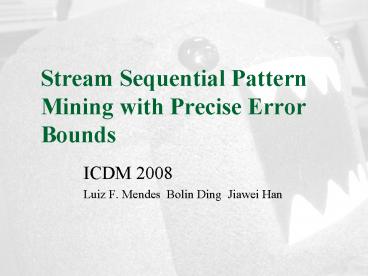Stream Sequential Pattern Mining with Precise Error Bounds - PowerPoint PPT Presentation
1 / 17
Title:
Stream Sequential Pattern Mining with Precise Error Bounds
Description:
Luiz F. Mendes Bolin Ding Jiawei Han. Outline. Introduction. Problem statement ... static database has been studied extensively by data mining researchers. ... – PowerPoint PPT presentation
Number of Views:156
Avg rating:3.0/5.0
Title: Stream Sequential Pattern Mining with Precise Error Bounds
1
Stream Sequential Pattern Mining with Precise
Error Bounds
- ICDM 2008
- Luiz F. Mendes Bolin Ding Jiawei Han
2
Outline
- Introduction
- Problem statement
- Two methods for mining sequential patterns
- Experimental
3
Introduction
- The problem of mining sequential patterns from a
large - static database has been studied extensively
by data mining researchers. This is an important
problem with many real-world applications such as
customer purchase behavior analysis, DNA sequence
analysis, and analysis of scienti?c experiments
4
Problem statement
- The count of a sequence s, denoted by count(s),
is de?ned as the number of sequences that contain
s. The support of a sequence s, denoted by
supp(s),is de?ned as count(s) divided by the
total number of sequences seen - If supp(s) s
- where s is a user-supplied minimum support
threshold
5
Problem statement(cont.)
- Example 1 Suppose the length of our data stream
is only 3 sequences S1 lta, b, cgt, S2 lta, cgt,
and S3 ltb, cgt. Let us assume we are given that
s 0.5. The set of sequential patterns and their
corresponding counts are as follows - ltagt2,ltbgt2,ltcgt3
- lta, cgt2,
- and ltb, cgt2.
6
Two methods for mining sequential patterns
- The SS-BE Method
- (Stream Sequence miner using Bounded Error)
- SS-MB
- (Stream Sequence miner using Memory Bounds).
7
The SS-BE Method
- Given a stream of sequences DS1,S2,
- Suppose the batch length L is 4,
- the minimum support threshold s is 0.75,
the significance threshold e is 0.5, the batch
support threshold a is 0.4 and the pruningperiod
d is 2. - Batch B1 lta,b,cgt,lta,cgt,lta,bgt,ltb,cgt
- Batch B2 lta,b,c,dgt,ltc,a,bgt,ltd,a,bgt,lta,e,bgt
- The stream length N 8
8
The SS-BE Method(cont.)
- To the first batch minimum support 0.4
- The frequent sequences found, followed by their
support counts - Batch B1 lta,b,cgt,lta,cgt,lta,bgt,ltb,cgt
- ltagt3 ltbgt3 ltcgt3
- lta,bgt2 lta,cgt2 ltb,cgt2
- inserted into the tree with the respective counts
and a batchCount of 1
9
The SS-BE Method(cont.)
- Again with support 0.4
- The frequent sequences found, followed by their
support counts - Batch B2 lta,b,c,dgt,ltc,a,bgt,ltd,a,bgt,lta,e,bgt
- ltagt4 ltbgt4 ltcgt2 ltdgt2 lta,bgt4
- ltagt,ltbgt,ltcgtandlta,bgt to have their counts
incremented by 4, 4, 2, and 4 add batchCount of 2 - And ltdgt batchCount is 1
10
The SS-BE Method(cont.)
- B1gt ltagt3 ltbgt3 ltcgt3 lta,bgt2 lta,cgt2 ltb,cgt2
- B2gt ltagt4 ltbgt4 ltcgt2 ltdgt2 lta,bgt4
11
The SS-BE Method(cont.)
- B B - batchCount
- ltagt ltbgt ltcgt lta,bgt
- batchCount2
- Other batchCount is 1
- a0.4
- d21 4 pruing
- c50 4 no pruing
12
The SS-BE Method(cont.)
- in this case count B 4
- error
- (s-e)N (0.75-0.5)82
- ltagt7 ltbgt7 ltcgt5 lta,bgt6
13
The SS-MB Method
- Given a stream of sequences DS1,S2,
- Suppose the batch length L is 4,
- the minimum support threshold s is 0.75,
the significance threshold e is 0.5 and the
maximum number of nodes allowed in the tree after
processing any given batch is 7 Batch B1
lta,b,cgt,lta,cgt,lta,bgt,ltb,cgt - Batch B2 lta,b,c,dgt,ltc,a,bgt,ltd,a,bgt,lta,e,bgt
- The stream length N 8
14
The SS-MB Method(cont.)
- B1gt ltagt3 ltbgt3 ltcgt3 lta,bgt2 lta,cgt2 ltb,cgt2
- B2gt ltagt4 ltbgt4 ltcgt2 ltdgt2 lta,bgt4
15
The SS-MB Method(cont.)
- Because there are now 8 nodes in the tree and the
maximum is 7, we must remove the sequence having
minimum count from the tree. Breaking ties
arbitrarily, the node corresponding to the
sequence ltb, cgt is removed. - The variable min is set to this sequences count
before being deleted, 2 - The algorithm outputs all sequences
corresponding to nodes having count above - New node
- Count min
- (s-e)N (0.75-0.5)82
16
Experimental
17
Experimental































